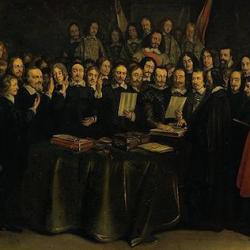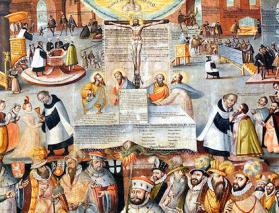“Denominational pluralism, on the American plan,” wrote Will Herberg, “means thoroughgoing secularization” (36).
By “secularization,” Herberg meant a gap between “conventional” and “operational” religion. Conventional religion is that practiced by religious adherents – Protestants, Catholics, Jews, Muslims, Buddhists. Operational religion is the set of beliefs, rituals, and values that shapes public life. Societies need a common religion to hold together. In traditional societies, the common operational religion is a conventional one; Christian communities can be “churches” in the Troeltschian sense – the national community at prayer. In a denominational system, no conventional religion is the operational religion. By definition, that means that denominational societies are secularized.
As Herberg puts it, “this country has not had a church since colonial times. The church, in this sense, is essentially the national community on its religious side, the national commimity religiously organized. Even where the transplanted religious bodies set up in the English colonies on the Atlantic Coast were churches to begin with, widespread religious dissidence, coupled with the diversity of population, soon broke the formal religious unity and induced an incipient denominationalism. Denominationalism became the established religious pattern in the wake of the great revival movements; and in denominationalism we have a further and very advanced stage of secularization. For denominationalism, in its very nature, requires a thoroughgoing separation between conventional religion and operative religion, and this is the mark of secularization” (35).
Even churches that are used to functioning as churches adjust to the American scene: “even American Catholics have come to think in such terms; theologically, the Catholic Church, of course, continues to regard itself as the one true church, but in their actual social attitudes American Catholics, hardly less than American Protestants or American Jews, tend to think of their church as a kind of denomination existing side by side with other denominations in a pluralistic harmony that is felt to be somehow of the texture of American life” (36).
The common faith within which conventional religions operate is, Herberg suggests, a trifaith of Protestant-Catholic-Jew (he was writing in 1962). This trifaith system is “the nation on its religious side” (39). This takes the place of the earlier unofficial establishment of Protestantism.
But his illustration of the “denominationalization” of the sect of Jehovah’s Witnesses suggests another direction. He cites a Witness article that gave instructions about dressing well. Herberg claimed that the article demonstrates leaders want “Witnesses [to] learn to fit into lower-middle-class suburbia and be accepted by it” (38). The common faith into which they want to be integrated is certainly colored by Protestant-Catholic-Jew; more fundamentally, it is the American way of life. The “nation on its religious side” may be no more than simply “the nation.”
Herberg knows this. He ends his lecture observing that conventional religions are “integrated into the ‘common religion’ of the American Way and made to serve a nonreligious function.” The result has been “increasingly vacuous” religious life.” Though religion is highly valued (in 1962), it is valued because it is a participation in the American Way, because “it is a religion thoroughly secularized and homogenized, a religion-in-general that is little more than a civic religion of democracy, the religionization of the American Way (44-5).
(Herberg, “Religion in a Secularized Society: The New Shape of Religion in America: Some Aspects of America’s Three Religion Pluralism,” Review of Religious Research 3 (1962) 33-45.)














